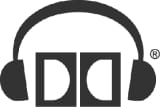What is Dolby Digital (AC3): quick guide, receiver, decoder

Launched in 1987, the Dolby Digital format is a digital audio encoding standard developed by Dolby Labs. Unlike Dolby ProLogic systems, Dolby Digital audio tracks are independent (the term "discrete" is also sometimes used).
What are its format details?
The Dolby Digital format's bandwidth falls between 20 Hz and 20 kHz, which is also the human hearing range (note that it varies between individuals).
Dolby Digital audio tape can be encoded in either of the following formats:
- Stereo.
- 5.1.
It should be noted that Dolby Digital is often incorrectly confused with the generic term 5.1.
For consumer electronics, the Dolby Digital format relies on a compression algorithm called Audio Coding 3 (AC3). This algorithm can compress audio streams by a factor of 10 to 12 with a 16-bit sampling rate of 48 kHz, for an overall bitrate of 384 kbps. For this reason, the Dolby Digital format is sometimes called Dolby AC3. For professionals, instead of an AC3 decoder, Dolby Digital uses a system called SR-D.
What are the independent audio channels?
The Dolby Digital format uses six independent audio channels:
- A central speaker, generally placed on the top of or above the screen, for reproducing dialogue.
- Two audio tracks for the front speakers accentuate the context of the sound coming from the central speaker.
- Two channels for the rear speakers used for reproducing noise and the sound environment in order to create ambiance.
- A channel for low frequencies (a subwoofer) for amplifying special effects (like explosions and earthquakes).
How to benefit from this format?
Dolby Digital is likely the most commonly used system in home theatre systems. To use media recorded in Dolby Digital format (DVD video or DVD audio, for example), you need a device with an integrated AC3 decoder. These devices are normally identified by the presence of the Dolby Digital logo:

What are Dolby Headphones?
The Dolby Headphone standard is used to privately enjoy surround sound with a traditional set of headphones, without bothering nearby people, using a stereo or multichannel source.
Dolby Headphone is based on a process called virtualization, which uses Head Related Transfer Functions (HRTF) to simulate 3D sound by taking into account the distortion of sound as it passes through the different parts of the listener's head, and combining this information with the acoustics of a virtual listening room.
Devices (like sound cards, home theatre systems, video game consoles, etc.) compatible with Dolby Headphones have this symbol:

What is Dolby Digital EX?
Dolby Digital EX has an additional channel (the term "6.1" is sometimes used) created with two rear channels to hide the sound gap that exists. Dolby Digital EX devices traditionally have the following logo:

However, a Dolby Digital EX can be read just as easily by a traditional Dolby Digital 5.1 decoder.

